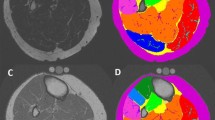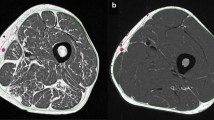Abstract
Objective
Determine the reliability of a magnetic resonance (MR) image segmentation protocol for quantifying intramuscular adipose tissue (IntraMAT), subcutaneous adipose tissue, total muscle and intermuscular adipose tissue (InterMAT) of the lower leg.
Materials and methods
Ten axial lower leg MRI slices were obtained from 21 postmenopausal women using a 1 Tesla peripheral MRI system. Images were analyzed using sliceOmatic™ software. The average cross-sectional areas of the tissues were computed for the ten slices. Intra-rater and inter-rater reliability were determined and expressed as the standard error of measurement (SEM) (absolute reliability) and intraclass coefficient (ICC) (relative reliability).
Results
Intra-rater and inter-rater reliability for IntraMAT were 0.991 (95 % confidence interval [CI] 0.978–0.996, p < 0.05) and 0.983 (95 % CI 0.958–9.993, p < 0.05), respectively. For the other soft tissue compartments, the ICCs were all >0.90 (p < 0.05). The absolute intra-rater and inter-rater reliability (expressed as SEM) for segmenting IntraMAT were 22.19 mm2 (95 % CI 16.97–32.04) and 78.89 mm2 (95 % CI 60.36–113.92), respectively.
Conclusion
This is a reliable segmentation protocol for quantifying IntraMAT and other soft-tissue compartments of the lower leg. A standard operating procedure manual is provided to assist users, and SEM values can be used to estimate sample size and determine confidence in repeated measurements in future research.

Similar content being viewed by others
References
United Nations DoEaSA, Population Division (2013) World population aging. United Nations, New York
Tinetti ME, Speechley M, Ginter SF (1988) Risk factors for falls among elderly persons living in the community. N Engl J Med 319(26):1701–1707. doi:10.1056/NEJM198812293192604
Stel VS, Smit JH, Pluijm SM, Lips P (2004) Consequences of falling in older men and women and risk factors for health service use and functional decline. Age Ageing 33(1):58–65
Tinetti ME, Williams CS (1997) Falls, injuries due to falls, and the risk of admission to a nursing home. N Engl J Med 337(18):1279–1284. doi:10.1056/NEJM199710303371806
Parkkari J, Kannus P, Palvanen M, Natri A, Vainio J, Aho H, Vuori I, Jarvinen M (1999) Majority of hip fractures occur as a result of a fall and impact on the greater trochanter of the femur: a prospective controlled hip fracture study with 206 consecutive patients. Calcifed Tissue Int 65(3):183–187
Osei WD, Rasali DP, Hawkey JB, McCrae SM, Johnson SJ (2007) Cost implications of falls injury hospitalizations in older residents in Saskatchewan, Canada. Ann Epidemiol 17(9):739
Stevens JA, Corso PS, Finkelstein EA, Miller TR (2006) The costs of fatal and non-fatal falls among older adults. Inj Prev J Int Soc Child Adolesc Inj Prev 12(5):290–295. doi:10.1136/ip.2005.011015
Bischoff-Ferrari HA, Orav JE, Kanis JA, Rizzoli R, Schlogl M, Staehelin HB, Willett WC, Dawson-Hughes B (2015) Comparative performance of current definitions of sarcopenia against the prospective incidence of falls among community-dwelling seniors age 65 and older. Osteoporos Int. doi:10.1007/s00198-015-3194-y
Moreland JD, Richardson JA, Goldsmith CH, Clase CM (2004) Muscle weakness and falls in older adults: a systematic review and meta-analysis. J Am Geriatr Soc 52(7):1121–1129. doi:10.1111/j.1532-5415.2004.52310.x
Rowan SL, Rygiel K, Purves-Smith FM, Solbak NM, Turnbull DM, Hepple RT (2012) Denervation causes fiber atrophy and myosin heavy chain co-expression in senescent skeletal muscle. PLoS One 7(1):e29082. doi:10.1371/journal.pone.0029082
Ochi A, Yokoyama S, Abe T, Yamada K, Tateuchi H, Ichihashi N (2014) Differences in muscle activation patterns during step recovery in elderly women with and without a history of falls. Aging Clin Exp Res 26(2):213–220. doi:10.1007/s40520-013-0152-4
Inacio M, Ryan AS, Bair WN, Prettyman M, Beamer BA, Rogers MW (2014) Gluteal muscle composition differentiates fallers from non-fallers in community dwelling older adults. BMC Geriatr 14:37. doi:10.1186/1471-2318-14-37
Cesari M, Leeuwenburgh C, Lauretani F, Onder G, Bandinelli S, Maraldi C, Guralnik JM, Pahor M, Ferrucci L (2006) Frailty syndrome and skeletal muscle: results from the Invecchiare in Chianti study. Am J Clin Nutr 83(5):1142–1148
Visser M, Goodpaster BH, Kritchevsky SB, Newman AB, Nevitt M, Rubin SM, Simonsick EM, Harris TB (2005) Muscle mass, muscle strength, and muscle fat infiltration as predictors of incident mobility limitations in well-functioning older persons. J Gerontol A Biol Sci Med Sci 60(3):324–333
Goodpaster BH, Park SW, Harris TB, Kritchevsky SB, Nevitt M, Schwartz AV, Simonsick EM, Tylavsky FA, Visser M, Newman AB (2006) The loss of skeletal muscle strength, mass, and quality in older adults: the health, aging and body composition study. J Gerontol A Biol Sci Med Sci 61(10):1059–1064
Marcus RL, Addison O, Dibble LE, Foreman KB, Morrell G, Lastayo P (2012) Intramuscular adipose tissue, sarcopenia, and mobility function in older individuals. J Aging Res 2012:629637. doi:10.1155/2012/629637
Tracy BL, Ivey FM, Hurlbut D, Martel GF, Lemmer JT, Siegel EL, Metter EJ, Fozard JL, Fleg JL, Hurley BF (1999) Muscle quality. II. Effects Of strength training in 65- to 75-yr-old men and women. J Appl Physiol 86(1):195–201
Lynch NA, Metter EJ, Lindle RS, Fozard JL, Tobin JD, Roy TA, Fleg JL, Hurley BF (1999) Muscle quality. I. Age-associated differences between arm and leg muscle groups. J Appl Physiol 86(1):188–194
Fragala MS, Kenny AM, Kuchel GA (2015) Muscle quality in aging: a multi-dimensional approach to muscle functioning with applications for treatment. Sports Med 45(5):641–658. doi:10.1007/s40279-015-0305-z
Gueugneau M, Coudy-Gandilhon C, Theron L, Meunier B, Barboiron C, Combaret L, Taillandier D, Polge C, Attaix D, Picard B, Verney J, Roche F, Feasson L, Barthelemy JC, Bechet D (2015) Skeletal muscle lipid content and oxidative activity in relation to muscle fiber type in aging and metabolic syndrome. J Gerontol A Biol Sci Med Sci 70(5):566–576. doi:10.1093/gerona/glu086
Lorbergs AL, Noseworthy MD, Adachi JD, Stratford PW, MacIntyre NJ (2015) Fat infiltration in the leg is associated with bone geometry and physical function in healthy older women. Calcifed Tissue Int. doi:10.1007/s00223-015-0018-1
Pritchard JM, Karampatos S, Beattie KA, Giangregorio LM, Ioannidis G, Atkinson SA, Thabane L, Gerstein H, Punthakee Z, Adachi JD, Papaioannou A (2015) The relationship between intramuscular adipose tissue, functional mobility, and strength in postmenopausal women with and without type 2 diabetes. J Aging Res 2015:872726. doi:10.1155/2015/872726
Tuttle LJ, Sinacore DR, Mueller MJ (2012) Intermuscular adipose tissue is muscle specific and associated with poor functional performance. J Aging Res 2012:172957. doi:10.1155/2012/172957
Goodpaster BH, Kelley DE, Thaete FL, He J, Ross R (2000) Skeletal muscle attenuation determined by computed tomography is associated with skeletal muscle lipid content. J Appl Physiol 89(1):104–110
Seidell JC, Bakker CJ, van der Kooy K (1990) Imaging techniques for measuring adipose-tissue distribution—a comparison between computed tomography and 1.5-T magnetic resonance. Am J Clin Nutr 51(6):953–957
Commean PK, Tuttle LJ, Hastings MK, Strube MJ, Mueller MJ (2011) Magnetic resonance imaging measurement reproducibility for calf muscle and adipose tissue volume. J Magn Reson Imaging 34(6):1285–1294. doi:10.1002/jmri.22791
Bartlett JW, Frost C (2008) Reliability, repeatability and reproducibility: analysis of measurement errors in continuous variables. Ultrasound Obstet Gynecol 31(4):466–475. doi:10.1002/uog.5256
Baumgartner TA (1989) Norm-referenced measurement: reliability. In: Safrit MJ, Wood TM (eds) Measurement concepts in physical education and exercise science. Human Kinetics, Champaign, pp 45–72
Cronbach LJ (2004) My current thoughts on coefficient alpha and successor procedures. Educ Psychol Meas 64(3):391–418
Norman GR, Streiner DL (2008) Repeated measures analysis. In: Abrams Farmer D (ed) Biostatistics: the bare essentials. BC Decker Inc, Hamilton, pp 113–114
Atkinson G, Nevill AM (1998) Statistical methods for assessing measurement error (reliability) in variables relevant to sports medicine. Sports Med 26(4):217–238
Szabo KA, Webber CE, Gordon C, Adachi JD, Tozer R, Papaioannou A (2010) Reproducibility of peripheral quantitative computed tomography measurements at the radius and tibia in healthy pre- and postmenopausal women. Can Assoc Radiol J. doi:10.1016/j.carj.2010.04.011
Mitsiopoulos N, Baumgartner RN, Heymsfield SB, Lyons W, Gallagher D, Ross R (1998) Cadaver validation of skeletal muscle measurement by magnetic resonance imaging and computerized tomography. J Appl Physiol 85(1):115–122
Demontiero O, Li W, Thembani E, Duque G (2011) Validation of noninvasive quantification of bone marrow fat volume with microCT in aging rats. Exp Gerontol 46(6):435–440. doi:10.1016/j.exger.2011.01.001
Organization WH (2008) Waist circumference and waist-hip ratio: report of an expert WHO consultation. World Health Organization, Geneva
Bonett DG (2002) Sample size requirements for estimating intraclass correlations with desired precision. Stat Med 21(9):1331–1335. doi:10.1002/sim.1108
Riddle DL, Stratford PW (2013) Is this change real? Interpreting patient outcomes in physical therapy. F.A. Davis Co., Philadelphia
Weir JP (2005) Quantifying test-retest reliability using the intraclass correlation coefficient and the SEM. J Strength Cond Res 19(1):231–240. doi:10.1519/15184.1
Vincent J (1994) Statistics in kinesiology. Human Kinetics, Champaign
Stratford PW, Goldsmith CH (1997) Use of the standard error as a reliability index of interest: an applied example using elbow flexor strength data. Phys Ther 77(7):745–750
Dufek JS, Bates BT, Davis HP (1995) The effect of trial size and variability on statistical power. Med Sci Sports Exerc 27(2):288–295
Alizai H, Nardo L, Karampinos DC, Joseph GB, Yap SP, Baum T, Krug R, Majumdar S, Link TM (2012) Comparison of clinical semi-quantitative assessment of muscle fat infiltration with quantitative assessment using chemical shift-based water/fat separation in MR studies of the calf of post-menopausal women. Eur Radiol 22(7):1592–1600. doi:10.1007/s00330-012-2404-7
Karampinos DC, Baum T, Nardo L, Alizai H, Yu H, Carballido-Gamio J, Yap SP, Shimakawa A, Link TM, Majumdar S (2012) Characterization of the regional distribution of skeletal muscle adipose tissue in type 2 diabetes using chemical shift-based water/fat separation. J Magn Reson Imaging JMRI 35(4):899–907. doi:10.1002/jmri.23512
Beattie KA, MacIntyre NJ, Ramadan K, Inglis D, Maly MR (2012) Longitudinal changes in intermuscular fat volume and quadriceps muscle volume in the thighs of women with knee osteoarthritis. Arthritis Care Res (Hoboken) 64(1):22–29. doi:10.1002/acr.20628
Federation ID (2014) IDF diabetes atlas. 6th edn. International Diabetes Foundation, Brussels
Reeder SB, Pineda AR, Wen Z, Shimakawa A, Yu H, Brittain JH, Gold GE, Beaulieu CH, Pelc NJ (2005) Iterative decomposition of water and fat with echo asymmetry and least-squares estimation (IDEAL): application with fast spin-echo imaging. Magn Reson Med 54(3):636–644. doi:10.1002/mrm.20624
Boettcher M, Machann J, Stefan N, Thamer C, Haring HU, Claussen CD, Fritsche A, Schick F (2009) Intermuscular adipose tissue (IMAT): association with other adipose tissue compartments and insulin sensitivity. J Magn Reson Imaging JMRI 29(6):1340–1345. doi:10.1002/jmri.21754
Marcus RL, Addison O, Kidde JP, Dibble LE, Lastayo PC (2010) Skeletal muscle fat infiltration: impact of age, inactivity, and exercise. J Nutr Health Aging 14(5):362–366
Acknowledgments
We would like to acknowledge the late Dr. Colin Webber for his passionate insight and guidance on this topic. We thank the study participants and staff at Hamilton Health Sciences Well-Health Centre and McMaster University Medical Centre Diabetes Outpatient Clinic who assisted with the study. In particular, Dr. Hertzel Gerstein and Dr. Zubin Punthakee were instrumental in assisting with participant recruitment. We would also like to thank Professor Paul Stratford for reviewing and providing feedback on the manuscript, Dr. Dean Inglis for developing the MRI imaging protocol, Yves Martel (Tomovision), Amanda Lorbergs and Mike Davison for reviewing the manual. JP was funded as a post-doctoral fellow by the Hamilton Health Sciences Foundation to complete this work.
Author information
Authors and Affiliations
Corresponding author
Ethics declarations
Conflict of interest
S. Karampatos, K. A. Beattie, M. Maly, A. Chan, J. M. Pritchard have no conflict of interest. A. Papaioannou has received grants, research support and/or honoraria from Amgen, Eli Lilly, Novartis, Warner Chilcott and Merck Canada. J. D. Adachi has received grants, research support and/or honoraria from Amgen, Eli Lilly, Novartis, Warner Chilcott and Merck Canada.
Ethical standards
All procedures performed in studies involving human participants were in accordance with the ethical standards of the institutional research committee (The Hamilton Integrated Research Ethics Board).
Informed consent
The Hamilton Integrated Research Ethics Board approved the study. Informed consent was obtained from all individual participants included in the study.
Electronic supplementary material
Below is the link to the electronic supplementary material.
Rights and permissions
About this article
Cite this article
Karampatos, S., Papaioannou, A., Beattie, K.A. et al. The reliability of a segmentation methodology for assessing intramuscular adipose tissue and other soft-tissue compartments of lower leg MRI images. Magn Reson Mater Phy 29, 237–244 (2016). https://doi.org/10.1007/s10334-015-0510-7
Received:
Revised:
Accepted:
Published:
Issue Date:
DOI: https://doi.org/10.1007/s10334-015-0510-7




